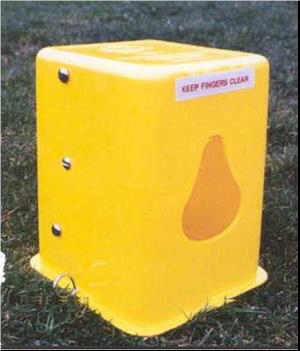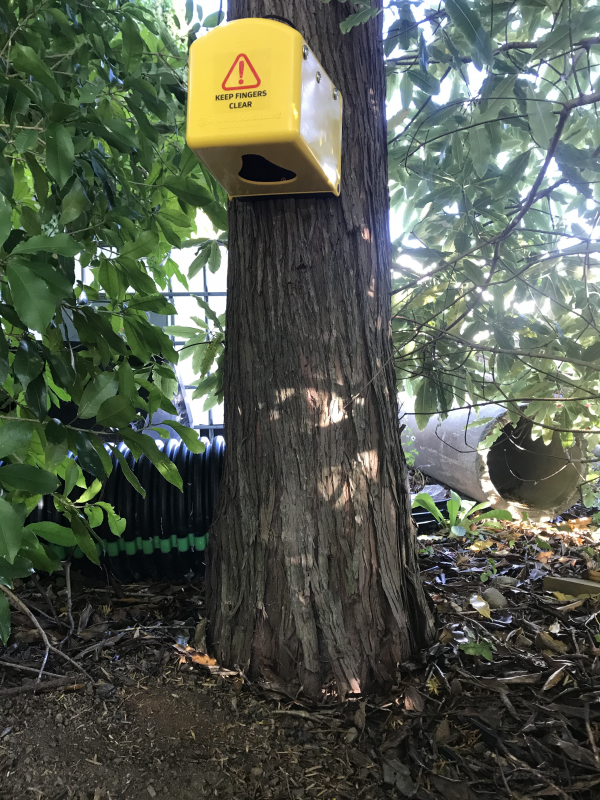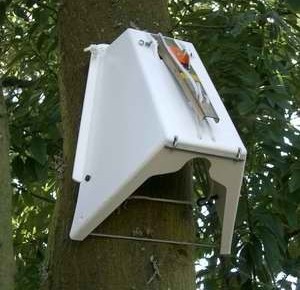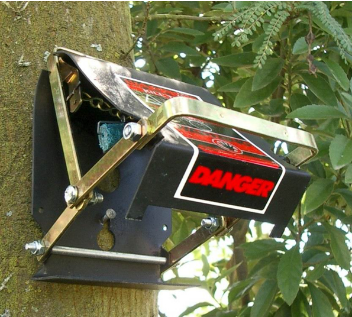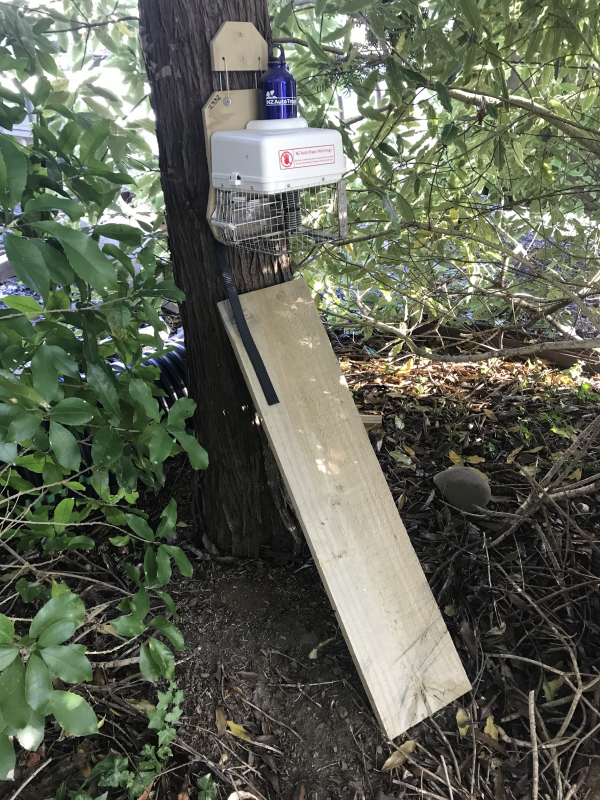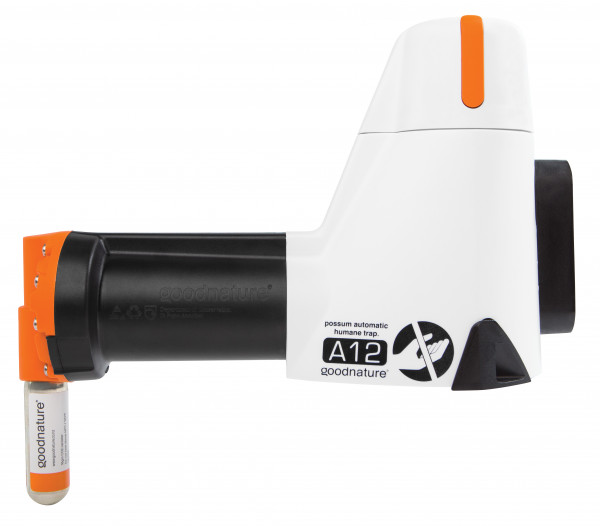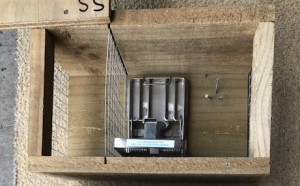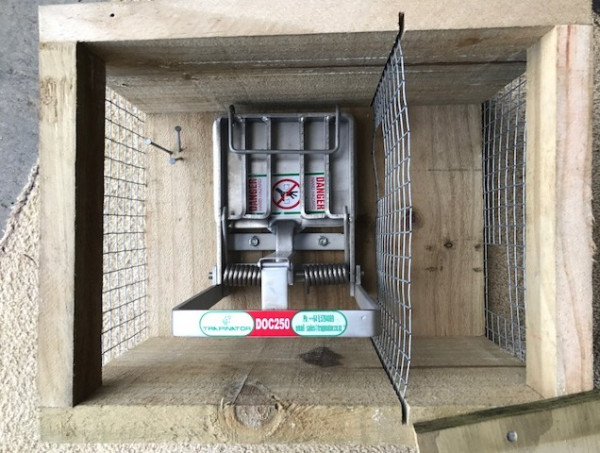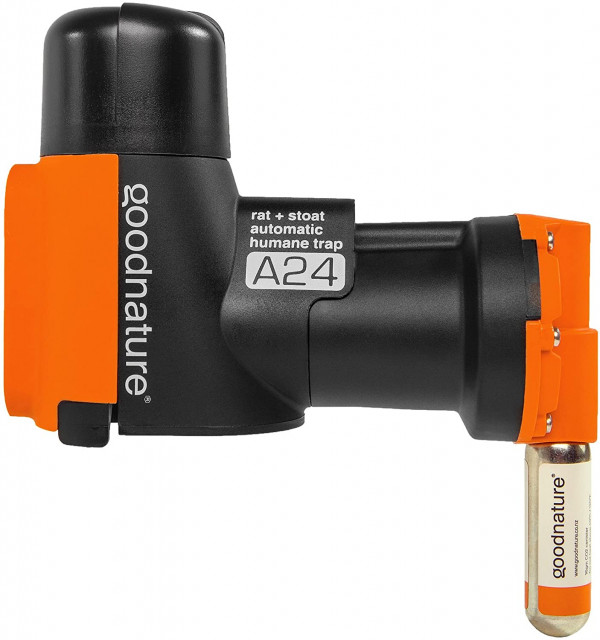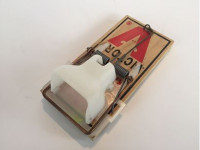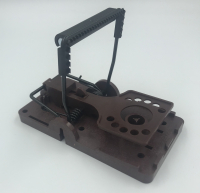Trapping
Trapping is a great way of protecting our native birds and lizards from introduced predator species such as rats, possums and mustelids (stoats, weasels and ferrets), and a great way to protect revegetation plantings, fruit tree and vegetable gardens and domestic foul.
There are lots of ways to get involved, including:
- Trapping in your own back yard
- Joining a community trapping group
- Getting involved in Predator Free Wellington
- Trapping on your rural property
If you're not sure which trap is best for your pest management situation, contact us for advice - email pest.animals@gw.govt.nz
| Trap name | Information |
|---|---|
|
Possums eat large amounts of native vegetation and prey on the eggs and young of native birds. They also damage crops and can carry bovine tuberculosis. Single set possum kill traps Kill traps are very effective when used correctly. These traps can be set on or above the ground depending on the location and trap type. In cases where a female possum with a joey is killed in a trap, it will be necessary to humanely euthanise the joey. Setting the trap Bait traps with fresh fruit, peanut butter or extruded cereal bait. Change the bait every 2 to 3 days and reset the trap each time it captures a possum. If the trap is attached to a tree, add a flour lure from the ground to the trap wiped on the tree trunk. Mix in some icing sugar, jelly crystals, or aniseed, vanilla or almond essence to make this extra attractive. |
|
|
Timms trap
|
The Timms trap is a yellow plastic case with a steel kill mechanism inside. It is set on the ground and secured with steel pegs. The trap is baited with fresh fruit, extruded cereal or polymer bait. The possum pushes its head through the opening on the front of the trap casing and pulls on the bait on the trap trigger. A spring-loaded metal bar is activated by the trigger, constricting the neck and killing the animal. Not pet and child safe: Not suitable around pets and children Where to buy: Greater Wellington Office (Upper Hutt only) |
|
Flipping Timmy trap
|
An optimised version of the Timms trap, with sturdier components. A quicker, easier and more versatile alternative, with a tree-mounted mechanism. Potentially pet and child safe: Okay to use if precautions are followed Where to buy: Zealandia, Nga Manu Nature Reserve, Akura Nursery and All Greater Wellington Offices |
|
Possum Master
|
The Possum Master trap is constructed with a plastic shell with a noose mechanism housed inside the casing. The trap is fixed to a tree and baited with fresh fruit, extruded cereal or polymer bait. The noose contracts around the neck when the possum takes the bait, killing the animal. Pet and child safe: ok to use if mounted at a safe height in a tree. Keep face clear of spring-loaded arm when set and while setting. Use fruit for bait if cats are present. Where to buy: Greater Wellington Offices (Upper Hutt and Masterton) |
|
Warrior trap
|
The Warrior is a steel construction kill-trap. It is set by mounting to a tree or fence and baited with fresh fruit, extruded cereal or polymer bait, inserted on the trap trigger. When the possum takes the bait the steel jaws of the trap clamps shut on the possum’s neck, killing the animal. Not pet and child safe: to be used in rural situations. Not safe for children, pets or livestock Where to buy: Buy online or email pest.animals@gw.govt.nz |
|
Auto-resetting traps These traps can be quite expensive, but require very little maintenance, and save you handling the carcasses. They are ideal for remote spots or if you haven’t the time to regularly service a trap. |
|
|
NZ Auto Traps AT220
|
The AT220 is the only kill self-resetting trap that can efficiently kill possums and rodents due to its two kill zones. Within the same trap is a crushing zone for rodents, and a strangle zone for possums. Up to 100 cycles and 12 months between services (bait refill and battery change). Slow-release non-toxin lure auto pump means lure always fresh. Light sensor deactivates trap during daylight and reactivates for night to improve safety for non-targets Not pet or child safe: to be used in rural situations. Place out of reach of dogs and stock. Cats generally show no interest, however mounting trap vertically will further reduce cat interaction risk. Keep hands outside trap shroud and handle with care. Where to buy: Buy online or email pest.animals@gw.govt.nz |
|
Goodnature A12
|
No longer manufactured, but GWRC still have quite a number in use around the region. This auto resetting trap kills twelve possums per gas cartridge, automatically resetting after each kill. It fires a piston when the possum bites down and pulls on the ‘bite block’ attached to a long life, non-toxic lure. The piston strikes the possum’s head, killing it instantly. |
| Trap name | Information |
|---|---|
|
Hedgehogs are nocturnal predators that consume invertebrates, ground-nesting bird eggs and small reptiles. Tunnel traps Traps for small mammals are more effective when they are inside a tunnel. The pest animal enters the tunnel through a small entrance at one end and crosses a trigger plate to reach the bait. Their weight on the trigger plate releases the spring-loaded trap which kills them. The traps need to be cleared and reset each time they capture a pest. Setting the trap Place fresh bait like meat or eggs on the elevated cradle (this sits a little higher than the trigger plate) to be at eye level for the pest animal. Avoid meat (and fish) if domestic cats are present - use eggs instead. Consider adding a mouse trap behind the other trap, at the rear of the box. Screw down the lid so it can’t be easily interfered with. For further advice, see: Trap predators in your backyard, Predator Free 2050: A practical guide for trapping. Buy a trap mechanism and build your own tunnel trap. |
|
|
DOC 150 trap |
The DOC 150 has a lighter trigger mechanism than the larger DOC traps. Potentially pet and child safe: Okay to use if precautions are followed Where to buy: Zealandia, Nga Manu Nature Reserve, Akura Nursery and All Greater Wellington Offices |
|
BT 200 trap
|
Trap inside a wooden tunnel, available in stainless steel or galvanised. Similar to the DOC200. Potentially pet and child safe: Okay to use if precautions are followed Where to buy: Zealandia, Nga Manu Nature Reserve, Akura Nursery and All Greater Wellington Offices |
|
DOC 200 trap |
Trap inside a wooden tunnel. This is the most used of the DOC and BT trapping series. Potentially pet and child safe: Okay to use if precautions are followed |
|
DOC 250 trap |
The DOC 250 is the largest of the DOC series traps and is designed to humanely trap and kill ferrets – the largest of the mustelid species in New Zealand. The DOC 250 is more difficult to set than the smaller traps and requires the use of a trap-setting tool. Potentially pet and child safe: Okay to use except with pet cats Where to buy: Zealandia, Nga Manu Nature Reserve, Akura Nursery and Greater Wellington Offices (Upper Hutt and Masterton) |
|
BT 250 trap
|
A trap similar to the DOC 250. A larger trap that will also capture ferrets. Needs a tool to set. Potentially pet and child safe: Okay to use except with pet cats Where to buy: Zealandia, Nga Manu Nature Reserve, Akura Nursery and Greater Wellington Offices (Upper Hutt and Masterton) |
|
Auto-resetting traps These traps can be quite expensive, but require very little maintenance, and save you handling the carcasses. They are ideal for remote spots or if you haven’t the time to regularly service a trap. |
|
|
Goodnature A24
|
Kills 24 rats, stoats, weasels or mice - automatically resetting after each kill. It works by firing a piston when the pest brushes against an internal trigger while trying to reach the long-life, non-toxic lure. The piston strikes the pest's head, killing it instantly. Find out more. Pet and child safe: Okay to use with pets and children Where to buy: Goodnature online shop and Predator free online shop |
Safety
Take care when setting and un-setting kill traps as they can cause injury if not handled correctly. Use the correct setting tool.
Ensure children and dogs are kept away from kill traps when they are set. Tunnel traps help keep the trap away from them.
Do not leave traps set for extended periods of time as the mechanism can become damaged or the metal parts may rust closed. Leaving carcasses to break down in the trap will corrode the metal of the trap over time.
| Trap name | Information |
|---|---|
|
Ferrets mainly prey on rabbits, hares, lizards, frogs, larger invertebrates, and native birds (they’re capable of killing adult kiwi and little blue penguins). They will also kill domestic fowl and small mammals. Tunnel traps Traps for small mammals are more effective when they are inside a tunnel. The pest animal enters the tunnel through a small entrance at one end and crosses a trigger plate to reach the bait. Their weight on the trigger plate releases the spring-loaded trap which kills them. The traps need to be cleared and reset each time they capture a pest. Setting the trap Place fresh bait like meat or eggs on the elevated cradle (this sits a little higher than the trigger plate) to be at eye level for the pest animal. Avoid meat (and fish) if domestic cats are present - use eggs instead. Consider adding a mouse trap behind the other trap, at the rear of the box. Screw down the lid so it can’t be easily interfered with. For further advice, see: Trap predators in your backyard, Predator Free 2050: A practical guide for trapping. Buy a trap mechanism and build your own tunnel trap. |
|
|
DOC 250 trap |
The DOC 250 is the largest of the DOC series traps and is designed to humanely trap and kill ferrets – the largest of the mustelid species in New Zealand. The DOC 250 is more difficult to set than the smaller traps and requires the use of a trap-setting tool. Potentially pet and child safe: Okay to use except with pet cats Where to buy: Zealandia, Nga Manu Nature Reserve, Akura Nursery and Greater Wellington Offices (Upper Hutt and Masterton) |
|
BT 250 trap
|
A trap similar to the DOC 250. A larger trap that will also capture ferrets. Needs a tool to set. Potentially pet and child safe: Okay to use except with pet cats Where to buy: Zealandia, Nga Manu Nature Reserve, Akura Nursery and Greater Wellington Offices (Upper Hutt and Masterton) |
|
Single set kill traps Kill traps are very effective when used correctly. These traps can be set on or above the ground depending on the location and trap type. Setting the trap Bait traps with meat but not in areas where domestic cats are present. Change the bait every few days and reset the trap each time it captures a ferret. |
|
|
Possum Master
|
The Possum Master trap is constructed with a plastic shell with a noose mechanism housed inside the casing. The trap is fixed to a tree and baited with meat, extruded cereal or polymer bait. The noose contracts around the neck when the ferret takes the bait, killing the animal. Pet and child safe: ok to use if mounted at a safe height in a tree. Keep face clear of spring-loaded arm when set and while setting. Use another type of trap if domestic cats are present. Where to buy: Greater Wellington Offices (Upper Hutt and Masterton) |
Safety
Take care when setting and un-setting kill traps as they can cause injury if not handled correctly. Use the correct setting tool.
Ensure children and dogs are kept away from kill traps when they are set. Tunnel traps help keep the trap away from them. If a kill trap is not recommended due to the presence of domestic cats, please contact us on pest.animals@gw.govt.nz for advice on non-lethal traps.
Do not leave traps set for extended periods of time as the mechanism can become damaged or the metal parts may rust closed. Leaving carcasses to break down in the trap will corrode the metal of the trap over time.
| Trap name | Information |
|---|---|
|
Stoats are a serious threat to our native animals. They prey on native birds, lizards and invertebrates and can kill domestic fowl. Tunnel traps Traps for small mammals are more effective when they are inside a tunnel. The pest animal enters the tunnel through a small entrance at one end and crosses a trigger plate to reach the bait. Their weight on the trigger plate releases the spring-loaded trap which kills them. The traps need to be cleared and reset each time they capture a pest. Setting the trap Use ‘weka length’ boxes (265mm gap between entry hole and internal baffle) with smaller entry holes to target stoats (and weasels) and avoid trapping larger untargeted animals. Use fresh bait like meat and eggs. Avoid meat (and fish) if domestic cats are present - use eggs instead, or, add a small tunnel or small block of wood inside the entrance so a cat can’t reach the trap with its paws. Place fresh bait on the elevated cradle which sits higher than the trigger plate and at eye level for the stoat. Consider adding a mouse trap behind the other trap, at the rear of the box. Screw down the lid so it can’t be easily interfered with. For further advice, see: Trap predators in your backyard, Predator Free 2050: A practical guide for trapping. Buy a trap mechanism and build your own tunnel trap. |
|
|
Modified Victor Pro trap with tunnel
|
Trap inside a wooden tunnel. Pet and child safe: Okay to use with pets and children Where to buy: Greater Wellington Office (Upper Hutt only) |
|
BT 200 trap
|
Trap inside a wooden tunnel, available in stainless steel or galvanised. Similar to the DOC200. Potentially pet and child safe: Okay to use if precautions are followed Where to buy: Zealandia, Nga Manu Nature Reserve, Akura Nursery and All Greater Wellington Offices |
|
DOC 200 trap |
Trap inside a wooden tunnel. This is the most used of the DOC and BT trapping series. Potentially pet and child safe: Okay to use if precautions are followed |
|
DOC 250 trap |
The DOC 250 is the largest of the DOC traps and will humanely kill stoats, as well as rats, hedgehogs and ferrets. It requires more strength to set than the smaller traps and so the use of a trap-setting tool is recommended. Potentially pet and child safe: Okay to use except with pet cats Where to buy: Zealandia, Nga Manu Nature Reserve, Akura Nursery and Greater Wellington Offices (Upper Hutt and Masterton) |
|
BT 250 trap
|
A trap similar to the DOC 250. A larger trap that will also capture stoats. Needs a tool to set. Potentially pet and child safe: Okay to use except with pet cats Where to buy: Zealandia, Nga Manu Nature Reserve, Akura Nursery and Greater Wellington Offices (Upper Hutt and Masterton) |
|
Auto-resetting traps These traps can be quite expensive, but require very little maintenance, and save you handling the carcasses. They are ideal for remote spots or if you don’t have time to regularly service a trap. |
|
|
Goodnature A24
|
Kills 24 rats, stoats, weasels or mice - automatically resetting after each kill. It works by firing a piston when the pest brushes against an internal trigger while trying to reach the long-life, non-toxic lure. The piston strikes the pest's head, killing it instantly. Find out more. Pet and child safe: Okay to use with pets and children Where to buy: Goodnature online shop and Predator free online shop |
Safety
Take care when setting and un-setting kill traps as they can cause injury if not handled correctly. Use the correct setting tool.
Ensure children and dogs are kept away from kill traps when they are set. Tunnel traps help keep the trap away from them.
Do not leave traps set for extended periods of time as the mechanism can become damaged or the metal parts may rust closed. Leaving carcasses to break down in the trap will corrode the metal of the trap over time.
| Trap name | Information |
|---|---|
|
Weasels are the smallest and least common of our three mustelid species, growing to 20-25cm long. Weasels present a serious threat to our native animals. They prey on native birds, eggs, lizards and invertebrates. Tunnel traps Traps for small mammals are more effective when they are inside a tunnel. The pest animal enters the tunnel through a small entrance at one end and crosses a trigger plate to reach the bait. Their weight on the trigger plate releases the spring-loaded trap which kills them. The traps need to be cleared and reset each time they capture a pest. Setting the trap Use ‘weka length’ boxes (265mm gap between entry hole and internal baffle) with smaller entry holes to target weasels and avoid trapping larger non target animals. Use fresh bait like meat and eggs. Avoid meat (and fish) if domestic cats are present - use eggs instead, or, add a small tunnel or small block of wood inside the entrance so a cat can’t reach the trap with its paws. Place fresh bait on the elevated cradle which sits higher than the trigger plate and at eye level for the stoat. Consider adding a mouse trap behind the other trap, at the rear of the box. Screw down the lid so it can’t be easily interfered with. For further advice, see: Trap predators in your backyard, Predator Free 2050: A practical guide for trapping. Buy a trap mechanism and build your own tunnel trap. |
|
|
Modified Victor Pro trap with tunnel
|
Trap inside a wooden tunnel. Pet and child safe: Okay to use with pets and children Where to buy: Greater Wellington Office (Upper Hutt only) |
|
DOC 150 trap |
The DOC 150 has a lighter trigger mechanism than the larger DOC traps. Potentially pet and child safe: Okay to use if precautions are followed Where to buy: Zealandia, Nga Manu Nature Reserve, Akura Nursery and All Greater Wellington Offices |
|
BT 200 trap
|
Trap inside a wooden tunnel, available in stainless steel or galvanised. Similar to the DOC200. Potentially pet and child safe: Okay to use if precautions are followed Where to buy: Zealandia, Nga Manu Nature Reserve, Akura Nursery and All Greater Wellington Offices |
|
DOC 200 trap |
Trap inside a wooden tunnel. This is the most used of the DOC and BT trapping series. Potentially pet and child safe: Okay to use if precautions are followed |
|
DOC 250 trap |
The DOC 250 is the largest of the DOC traps and will kill weasels in addition to rats, stoats, hedgehogs and ferrets. It requires more strength to set than the smaller traps and so the use of a trap-setting tool is recommended. Potentially pet and child safe: Okay to use except with pet cats Where to buy: Zealandia, Nga Manu Nature Reserve, Akura Nursery and Greater Wellington Offices (Upper Hutt and Masterton) |
|
BT 250 trap
|
A trap similar to the DOC 250. A larger trap that will also capture weasels. Needs a tool to set. Potentially pet and child safe: Okay to use except with pet cats Where to buy: Zealandia, Nga Manu Nature Reserve, Akura Nursery and Greater Wellington Offices (Upper Hutt and Masterton) |
|
Auto-resetting traps These traps can be quite expensive, but require very little maintenance, and save you handling the carcasses. They are ideal for remote spots or if you don’t have time to regularly service a trap. |
|
|
Goodnature A24
|
Kills 24 rats, stoats, weasels or mice - automatically resetting after each kill. It works by firing a piston when the pest brushes against an internal trigger while trying to reach the long-life, non-toxic lure. The piston strikes the pest's head, killing it instantly. Find out more. Pet and child safe: Okay to use with pets and children Where to buy: Goodnature online shop and Predator free online shop |
Safety
Take care when setting and un-setting kill traps as they can cause injury if not handled correctly. Use the correct setting tool.
Ensure children and dogs are kept away from kill traps when they are set. Tunnel traps help keep the trap away from them.
Do not leave traps set for extended periods of time as the mechanism can become damaged or the metal parts may rust closed. Leaving carcasses to break down in the trap will corrode the metal of the trap over time.
| Trap name | Information |
|---|---|
|
Rats are omnivorous, opportunistic feeders. They eat a variety of native flora and fauna, including bird eggs and fledglings, invertebrates, lizards and frogs. Rats compete with native species for the same food sources and in some cases for nests and burrows. Tunnel traps Traps for small mammals are more effective when they are inside a tunnel. The pest animal enters the tunnel through a small entrance at one end and crosses a trigger plate to reach the bait. Their weight on the trigger plate releases the spring-loaded trap which kills them. The traps need to be cleared and reset each time they capture a pest. Setting the trap Rats like to run near walls, plants and fences rather than through open spaces. They also like areas that have food sources, like compost or fruit trees. Place fresh bait (peanut butter is best!) on the elevated cradle which sits higher than the trigger plate to be at eye level for the rats. Use ‘weka length’ boxes (265mm gap between entry hole and internal baffle) with smaller entry holes to avoid trapping larger non target animals. If domestic cats are present, you can add a small tunnel or small block of wood inside the entrance so a cat can’t reach the trap with its paws. Consider adding a mouse trap behind the other trap, at the rear of the box. Screw down the lid so it can’t be easily interfered with. For further advice, see: Trap predators in your backyard, Predator Free 2050: A practical guide for trapping. Buy a trap mechanism and build your own tunnel trap. |
|
|
Monster trap
|
Trap inside a plastic case. Pet and child safe: Okay to use with pets and children Where to buy: Buy online from PEST STOP |
|
Victor Pro trap with tunnel 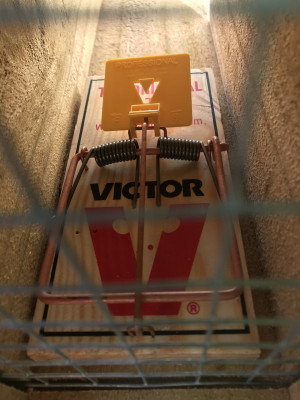 |
Trap inside a wooden tunnel. Pet and child safe: Okay to use with pets and children Where to buy: Zealandia, Nga Manu Nature Reserve, Akura Nursery and All Greater Wellington Offices |
|
Modified Victor Pro trap with tunnel
|
Trap inside a wooden tunnel. Pet and child safe: Okay to use with pets and children Where to buy: Greater Wellington Office (Upper Hutt only) |
|
DOC 150 trap |
The DOC 150 has a lighter trigger mechanism than the larger DOC traps. Potentially pet and child safe: Okay to use if precautions are followed Where to buy: Zealandia, Nga Manu Nature Reserve, Akura Nursery and All Greater Wellington Offices |
|
BT 200 trap
|
Trap inside a wooden tunnel, available in stainless steel or galvanised. Similar to the DOC200. Potentially pet and child safe: Okay to use if precautions are followed Where to buy: Zealandia, Nga Manu Nature Reserve, Akura Nursery and All Greater Wellington Offices |
|
DOC 200 trap |
Trap inside a wooden tunnel. This is the most used of the DOC and BT trapping series. Potentially pet and child safe: Okay to use if precautions are followed |
|
DOC 250 trap |
The DOC 250 is the largest of the DOC traps and will humanely kill rats as well as stoats, hedgehogs and ferrets. It requires more strength to set than the smaller traps and so the use of a trap-setting tool is recommended. Potentially pet and child safe: Okay to use except with pet cats Where to buy: Zealandia, Nga Manu Nature Reserve, Akura Nursery and Greater Wellington Offices (Upper Hutt and Masterton) |
|
BT 250 trap
|
A trap similar to the DOC 250. A larger trap that will also capture rats. Needs a tool to set. Potentially pet and child safe: Okay to use except with pet cats Where to buy: Zealandia, Nga Manu Nature Reserve, Akura Nursery and Greater Wellington Offices (Upper Hutt and Masterton) |
|
Auto-resetting traps These traps can be quite expensive, but require very little maintenance, and save you handling the carcasses. They are ideal for remote spots or if you haven’t the time to regularly service a trap. |
|
|
Goodnature A24
|
Kills 24 rats, stoats, weasels or mice - automatically resetting after each kill. It works by firing a piston when the pest brushes against an internal trigger while trying to reach the long-life, non-toxic lure. The piston strikes the pest's head, killing it instantly. Find out more. Pet and child safe: Okay to use with pets and children Where to buy: Goodnature online shop and Predator free online shop |
|
NZ Auto Traps AT220
|
The AT220 is the only kill self-resetting trap that can efficiently kill possums and rodents due to its two kill zones. Within the same trap is a crushing zone for rodents, and a strangle zone for possums. Up to 100 cycles and 12 months between services (bait refill and battery change). Slow-release non-toxin lure auto pump means lure always fresh. Light sensor deactivates trap during daylight and reactivates for night to improve safety for non-targets Not pet or child safe: to be used in rural situations. Place out of reach of dogs and stock. Cats generally show no interest, however mounting trap vertically will further reduce cat interaction risk. Keep hands outside trap shroud and handle with care. Where to buy: Buy online or email pest.animals@gw.govt.nz |
Safety
Take care when setting and un-setting kill traps as they can cause injury if not handled correctly. Use the correct setting tool.
Ensure children and dogs are kept away from kill traps when they are set. Tunnel traps help keep the trap away from them.
Do not leave traps set for extended periods of time as the mechanism can become damaged or the metal parts may rust closed. Leaving carcasses to break down in the trap will corrode the metal of the trap over time.
| Trap name | Information |
|---|---|
|
Although small, mice have large impacts due to them consuming native invertebrates and seeds. They also damage crops and food. Auto-resetting traps These traps can be quite expensive, but require very little maintenance, and save you handling the carcasses. Setting the trap They are ideal for remote spots or if you haven’t the time to regularly service a trap. Rats and mice like to run near walls, plants and fences rather than through open spaces. They also like areas that have food sources, like compost or fruit trees. Mice are attracted to fat. Lures to try in traps include cheese, milk chocolate, Nutella and walnuts, according to 2016 Victoria University study. For further advice, see: Trap predators in your backyard, Predator Free 2050: A practical guide for trapping. |
|
|
Goodnature A24
|
Kills 24 rats, stoats, weasels or mice - automatically resetting after each kill. It works by firing a piston when the pest brushes against an internal trigger while trying to reach the long-life, non-toxic lure. The piston strikes the pest's head, killing it instantly. Find out more. Pet and child safe: Okay to use with pets and children Where to buy: Goodnature online shop and Predator free online shop |
| Trap name | Information | Target animals |
|---|---|---|
|
Tunnel traps Traps for small mammals are more effective when they are inside a tunnel. The pest animal enters the tunnel through a small entrance at one end and crosses a trigger plate to reach the bait. Their weight on the trigger plate releases the spring-loaded trap which kills them. The traps need to be cleared and reset each time they capture a pest. Setting the trap Use ‘weka length’ boxes (265mm gap between entry hole and internal baffle) with smaller entry holes to target stoats and weasels and avoid trapping larger non target animals. To attract mustelids, use fresh bait like meat and eggs. Avoid meat (and fish) if domestic cats are present - use eggs instead, or, add a small tunnel or small block of wood inside the entrance so a cat can’t reach the trap with its paws. Fresh peanut butter works well to attract rats. Rats and mice like to run near walls, plants and fences rather than open spaces. They also like areas that have food sources, like compost or fruit trees. Place fresh bait on the elevated cradle which sits higher than the trigger plate and at eye level for the pest animal. Consider adding a mouse trap behind the other trap, at the rear of the box. Screw down the lid so it can’t be easily interfered with. For further advice, see: Trap predators in your backyard, Predator Free 2050: A practical guide for trapping. Buy a trap mechanism and build your own tunnel trap. |
||
|
Monster trap
|
Trap inside a plastic case. Pet and child safe: Okay to use with pets and children Where to buy: Buy online from PEST STOP |
Rats |
|
Victor Pro trap with tunnel  |
Trap inside a wooden tunnel. Pet and child safe: Okay to use with pets and children Where to buy: Zealandia, Nga Manu Nature Reserve, Akura Nursery and All Greater Wellington Offices |
|
|
Modified Victor Pro trap with tunnel
|
Trap inside a wooden tunnel. Pet and child safe: Okay to use with pets and children Where to buy: Greater Wellington Office (Upper Hutt only) |
Stoats, weasels, rats |
|
DOC 150 trap |
The DOC 150 has a lighter trigger mechanism than the larger DOC traps. Potentially pet and child safe: Okay to use if precautions are followed Where to buy: Zealandia, Nga Manu Nature Reserve, Akura Nursery and All Greater Wellington Offices |
Hedgehogs, weasels, rats |
|
BT 200 trap
|
Trap inside a wooden tunnel, available in stainless steel or galvanised. Similar to the DOC200. Potentially pet and child safe: Okay to use if precautions are followed Where to buy: Zealandia, Nga Manu Nature Reserve, Akura Nursery and All Greater Wellington Offices |
Stoats, weasels, rats, hedgehogs |
|
DOC 200 trap |
Trap inside a wooden tunnel. This is the most used of the DOC and BT trapping series. Potentially pet and child safe: Okay to use if precautions are followed |
|
|
DOC 250 trap |
The DOC 250 is the largest of the DOC traps and will humanely kill rats, stoats, rats, hedgehogs and ferrets. It requires more strength to set than the smaller traps and so the use of a trap-setting tool is recommended. Potentially pet and child safe: Okay to use except with pet cats Where to buy: Zealandia, Nga Manu Nature Reserve, Akura Nursery and Greater Wellington Offices (Upper Hutt and Masterton) |
Ferrets, stoats, weasels, rats, hedgehogs |
|
BT 250 trap
|
A trap similar to the DOC 250. A larger trap that will also capture ferrets. Needs a tool to set. Potentially pet and child safe: Okay to use except with pet cats Where to buy: Zealandia, Nga Manu Nature Reserve, Akura Nursery and Greater Wellington Offices (Upper Hutt and Masterton) |
|
|
Single set possum kill traps Possums consume large amounts of native vegetation and predate on the eggs and young of native birds. They also do considerable damage to agricultural and horticultural crops and can carry bovine tuberculosis. There are a variety of possum traps available that can kill capture possums alive. Kill traps are very effective when used correctly. These traps can be set on or above the ground depending on the location and trap type. Setting the trap Bait these traps with fresh fruit, peanut butter or extruded cereal bait. Change the bait every 2 to 3 days and reset the trap each time it captures a possum. If the trap is attached to a tree, add a flour lure from the ground to the trap wiped on the tree trunk. Mix in some icing sugar, jelly crystals, aniseed, vanilla or almond essence to make this extra attractive. |
||
|
Timms trap
|
The Timms trap is a yellow plastic case with a steel kill mechanism inside. It is set on the ground and secured with steel pegs. The trap is baited with fresh fruit, extruded cereal or polymer bait. The possum pushes its head through the opening on the front of the trap casing and pulls on the bait on the trap trigger. A spring-loaded metal bar is activated by the trigger, constricting the neck and killing the animal. Not pet and child safe: Not suitable for use around pets and children Where to buy: Greater Wellington Office (Upper Hutt only) |
Possums |
|
Flipping Timmy trap
|
An optimised version of the Timms trap, with sturdier components. A quicker, easier and more versatile alternative, with a tree-mounted mechanism. Potentially pet and child safe: Okay to use if precautions are followed Where to buy: Zealandia, Nga Manu Nature Reserve, Akura Nursery and All Greater Wellington Offices |
|
|
Possum Master
|
The Possum Master trap is constructed with a plastic shell with a noose mechanism housed inside the casing. The trap is fixed to a tree and baited with fresh fruit, extruded cereal or polymer bait. The noose contracts around the neck when the possum takes the bait, killing the animal. Pet and child safe: ok to use if mounted at a safe height in a tree. Keep face clear of spring-loaded arm when set and while setting. Use fruit for bait if cats are present. Where to buy: Greater Wellington Offices (Upper Hutt and Masterton) |
|
|
Warrior trap
|
The Warrior is a steel construction kill-trap. It is set by mounting to a tree or fence and baited with fresh fruit, extruded cereal or polymer bait, inserted on the trap trigger. When the possum takes the bait the steel jaws of the trap clamps shut on the possum’s neck, killing the animal. Not pet and child safe: to be used in rural situations. Not safe for children, pets or livestock Where to buy: Buy online or email pest.animals@gw.govt.nz |
|
|
Auto-resetting traps These traps can be quite expensive, but can kill a range of pest animals, require very little maintenance, and save you handling the carcasses. They are ideal for remote spots or if you haven’t the time to regularly service a trap. |
||
|
Goodnature A24
|
Kills 24 rats, stoats, weasels or mice - automatically resetting after each kill. It works by firing a piston when the pest brushes against an internal trigger while trying to reach the long-life, non-toxic lure. The piston strikes the pest's head, killing it instantly. Find out more. Pet and child safe: Okay to use with pets and children Where to buy: Goodnature online shop and Predator free online shop |
Stoats, weasels, rats, mice, hedgehogs |
|
NZ Auto Traps AT220
|
The AT220 is the only kill self-resetting trap that can efficiently kill possums and rodents due to its two kill zones. Within the same trap is a crushing zone for rodents, and a strangle zone for possums. Up to 100 cycles and 12 months between services (bait refill and battery change). Slow-release non-toxin lure auto pump means lure always fresh. Light sensor deactivates trap during daylight and reactivates for night to improve safety for non-targets Not pet or child safe: to be used in rural situations. Place out of reach of dogs and stock. Cats generally show no interest, however mounting trap vertically will further reduce cat interaction risk. Keep hands outside trap shroud and handle with care. Where to buy: Buy online or email pest.animals@gw.govt.nz |
Possums, rats |
|
Goodnature A12
|
No longer manufactured, but GWRC still have quite a number in use around the region. This auto resetting trap kills twelve possums per gas cartridge, automatically resetting after each kill. It fires a piston when the possum bites down and pulls on the ‘bite block’ attached to a long life, non-toxic lure. The piston strikes the possum’s head, killing it instantly. |
Possums |
Safety
Take care when setting and un-setting kill traps as they can cause injury if not handled correctly. Use the correct setting tool.
Ensure children and dogs are kept away from kill traps when they are set. Tunnel traps help keep the trap away from them.
Do not leave traps set for extended periods of time as the mechanism can become damaged or the metal parts may rust closed. Leaving carcasses to break down in the trap will corrode the metal of the trap over time.
Finding a good spot
Make sure to place the trap on flat, solid ground so that it doesn’t move or rock. Some animals don’t like entering boxes that are unstable. You can secure it with pegs or a heavy object if needed.
When your trap is in a stable location, you can set and bait it. Wear gloves as some animals are put off by human scent.
Clear weeds from around the trap ends. This allows for access and air flow through the box, keeping the bait fresher for longer.
Create a path to the trap entrance to attract attention and lure pests to the trap. Freshly cleared ground will also attract them.
If you aren’t getting results, try a different spot.
Service and maintenance
Remove and discard all old bait away from the trap. Replace with fresh bait.
Dispose of carcasses by burying or wrapping in newspaper and putting in household rubbish. If you'r interested you can record the catches on the trap.nz website (this site allows you to share your information).
Clear any weeds from around the trap box.
Check wire mesh holes are smooth with no sharp points.
Note the condition of the trap and anything that needs to be fixed.
Check the trigger plate is level.
Test the trap by lowering the trigger slowly and adjusting if needed. The ideal weight to trigger the plate is 70-100 grams.
Upgrade to a stainless-steel option for trapping in coastal areas.
Safety first!
Some traps have specific safety instructions, depending on how they work and where they are placed. The golden rules for safe trapping are:
- Don't touch traps unless authorised to do so
- Keep children and dogs away from traps when they are set
- Maintain traps so they work efficiently
- Keep your traps on your property and not on public land.
Get in touch
- Phone:
- 0800 496 734
- Email:
- info@gw.govt.nz

